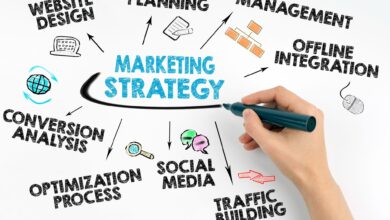Best Digital Marketing Strategies 2024

Best Digital Marketing Strategies 2024
Introduction
Digital marketing has become essential for businesses of all sizes that want to reach and engage with customers in the digital age. As consumer behavior and technology continue to evolve, companies must adapt their marketing strategies to stay competitive and drive growth.
In 2024, digital marketing will look quite different than it does today. New platforms, formats, and devices will shape how brands connect with audiences. Data and personalization will become even more integral to providing relevant, valuable experiences that build loyalty and trust. Agile, innovative approaches will be required to keep pace with the speed of digital change.
This article explores the top digital marketing strategies that leading companies will leverage in 2024 to attract, convert, and delight customers in a crowded online marketplace. As we enter this next era of digital transformation, the strategies outlined here can help future-proof your marketing plans. Adopting these best practices now will enable you to enter 2024 with confidence, ready to maximize results and ROI.
Best SEO Strategies for 2024
Search engine optimization (SEO) will continue to be a critical digital marketing strategy in 2024. With more businesses competing for rankings on search engines like Google, having an effective SEO strategy is more important than ever. Here are some best practices brands should focus on for SEO success in 2024:
Conduct Thorough Keyword Research
The foundation of any good SEO strategy is keyword research. You need to identify the main keywords and phrases that your target audience is searching for, and then optimize your content accordingly. Use keyword research tools like Google Keyword Planner, SEMrush and Moz Keyword Explorer to find low competition, high traffic keywords to target.
Optimize Site Architecture
The structure and technical foundation of your website has a big impact on SEO. Make sure your site has a sitemap XML file, internal links between related content, clean URL structures, optimized page titles and meta descriptions. Aim for a more seamless user experience.
Create SEO-Friendly Content
Optimizing on-page content elements is crucial for rankings. Focus on producing in-depth, useful content organized around your core keywords. Include keywords naturally in titles, headings, opening paragraphs, image alt text, etc. Answer people’s key questions and provide value.
Get Backlinks from Relevant Sites
Backlinks remain one of the strongest ranking signals. Build natural links from industry websites through guest posting, partnerships, integration into lists/roundups. Focus on earning backlinks from reputable, high-authority sites related to your niche.
Leverage Google Business Profiles
Having a complete, optimized Google Business Profile makes it easier for local customers to find and connect with you. Fill out your profile fully, add photos/videos, encourage customer reviews, and keep information updated. Link your website to your GBP for better integration.
Analyze and Refine Efforts
Track your website’s SEO metrics like rankings, traffic, clickthrough rate. Identify pages that are underperforming for core terms. Refine on-page elements, earn more backlinks, and optimize technical site elements for continuous improvements. Stay updated on Google’s algorithm changes.
Following an SEO strategy focused on these key elements will help your website attract more qualified visitors and customers from organic search in 2024. Adjust plans based on your resources and business goals. With regular refinement and monitoring, your efforts will yield better search visibility over time.
Content Marketing
Content marketing involves creating and sharing high-quality, valuable content to attract and retain an audience, rather than directly selling products or services. It focuses on providing information that makes you a trusted expert. There are many types of content that can be leveraged:
Blogs
- Long-form written content published regularly (e.g. weekly/monthly)
- Allows you to dive deep into topics and keywords to rank high in search
- Builds relationships by providing ongoing value to readers
- Content can be promoted on social media to drive traffic
Videos
- Engaging way to communicate and build brand awareness
- Allows you to show your knowledge and personality
- Can be embedded on blogs/social media and used in paid ads
- Short videos work well for tutorials or announcements
Infographics
- Visual representations of data, statistics, tips
- Quickly communicate complex information
- Ideal for creating shareable social media content
- Can support and amplify your blog/video content
Ebooks / Whitepapers
- In-depth guides focused on solving reader problems
- Offer as opt-in lead magnets in exchange for contact info
- Promote gated versions on blogs and social, distribute freely elsewhere
- Establish thought leadership and generate leads
Creating a content strategy focused on consistently publishing quality content allows you to drive organic growth by providing value to your audience. The key is ensuring the content directly serves your ideal customers’ needs and interests.
Social Media Marketing
Social media marketing will continue to be a critical part of any digital marketing strategy in 2024. With over 4.5 billion social media users worldwide, platforms like Facebook, Instagram, Twitter, LinkedIn, YouTube, TikTok, and more offer unparalleled opportunities to connect with target audiences.
When choosing platforms, focus on where your audience is already active and engaged. Tailor content and messaging appropriately for each platform. For example, short-form video excels on TikTok, while in-depth articles work well on LinkedIn.
Develop engaging, valuable content that encourages sharing and interaction. Humanize your brand by showcasing company culture, behind-the-scenes footage, employee spotlights, and more. Respond to comments and questions to foster relationships with followers.
Social media ads enable precise targeting by location, demographics, interests, and behaviors. Test different audiences, placements, and messaging to optimize campaign performance. Leverage re-marketing and custom audiences from website visitors.
Measure ROI by tracking conversions, web traffic, and sales driven by social platforms. Set up UTMs to track engagement. Monitor brand awareness and sentiment. Continuously refine strategies based on data and trends.
The future success of brands will rely heavily on creative, strategic social media marketing. Companies that best engage their audiences while conveying core values will achieve significant competitive advantage.
Email Marketing
Email marketing remains one of the most effective digital marketing channels. Building and segmenting an email subscriber list allows for targeted, automated messaging that drives conversions.
Some best practices for email marketing in 2024 include:
- Focus on list-building. Offer opt-in incentives like discounts or exclusive content to grow your subscriber list. Concentrate on acquiring targeted, high-quality leads that actually want to hear from you.
- Segment your list. Divide subscribers into groups based on demographics, interests, and behaviors. Send targeted content to each segment that resonates better.
- Personalize emails. Include the recipient’s first name, purchase history, or location to make emails feel customized. Personalized subject lines can also improve open rates.
- Test and optimize. A/B test different subject lines, content, designs, timing, and segments. Analyze results to refine your approach and increase engagement.
- Automate campaigns. Develop sequences like welcome series, cart abandonment flows, weekly digests, etc. Automation nurtures leads and boosts sales with minimal effort.
- Focus on mobile optimization. With high mobile usage, optimize emails for smaller screens. Ensure easy readability, scanning, clicking, and sharing on mobile devices.
- Leverage analytics. Track key metrics like open, clickthrough, and conversion rates. Review insights to continually refine your email approach for better results.
With thoughtful list-building, segmentation, personalization, automation, testing, and analytics, email marketing can drive substantial ROI in 2024 and beyond.
Paid Search (PPC)
Paid search, also known as pay-per-click (PPC) advertising, will continue to be an essential digital marketing strategy in 2024. With paid search, marketers create ads that appear on search engine results pages when users search for specific keywords related to their business. The most common paid search platforms are Google Ads and Microsoft Advertising.
Some best practices for optimizing paid search campaigns in 2024 include:
- Focusing on high-intent keywords that indicate users are actively looking to purchase products or services. Stay away from broad, low-intent keywords.
- Creating tightly-themed ad groups around specific products, services or categories. This allows for more relevant ads and advanced keyword targeting.
- Researching and testing ad variations to identify which headlines, descriptions and calls-to-action perform best. A/B test ads regularly.
- Utilizing responsive search ads and ad customizers to serve dynamic, personalized ads that drive more clicks and conversions.
- Refining landing pages to match ad messaging and provide clear calls-to-action for visitors. Use landing page analytics to optimize.
- Monitoring search query reports to find additional relevant keywords and adjust bids accordingly. Expand high-performing keyword lists.
- Structuring campaigns appropriately, separating branding keywords from those driving direct conversions. Set specific goals per campaign.
- Using location targeting and schedule adjustments to focus spend on highest-converting regions and days/times.
- Optimizing for conversions rather than clicks by bidding higher on keywords likely to convert and lowering bids for clicks unlikely to convert.
By focusing paid search efforts on relevant, high-intent keywords and crafting compelling ad messaging that drives conversions, businesses can get the most value from their PPC budgets in 2024. Continuous testing and optimization based on data will be key.
Marketing Analytics
Marketing analytics focuses on measuring, managing and analyzing marketing data to optimize results and maximize return on investment (ROI). Marketers can leverage analytics to gain valuable insights into their target audience, campaign performance, content effectiveness and more. Here are some key aspects of marketing analytics:
Identifying Key Performance Indicators (KPIs)
Setting the right KPIs allows marketers to track progress towards business objectives. Examples of marketing KPIs:
- Website traffic
- Bounce rate
- Conversion rate
- Sales revenue
- Return on ad spend (ROAS)
Leveraging Data
Marketing analytics relies on collecting and compiling data from multiple sources. This data can include:
- Website analytics (Google Analytics, Adobe Analytics)
- CRM data
- Email marketing analytics
- Social media analytics
- Campaign tracking and attribution
Tools and Software
Powerful tools provide marketers with the ability to visualize, analyze and extract insights from their data. Top marketing analytics tools include:
- Google Analytics
- Adobe Analytics
- Salesforce Datorama
- Tableau
- Google Data Studio
- Mixpanel
- Heap Analytics
Driving Optimal Marketing Decisions
The most important application of marketing analytics is using data to guide strategic and tactical choices. Examples include:
- Optimizing underperforming campaigns and content
- Identifying high-converting marketing channels
- Personalizing experiences to improve engagement
- Forecasting future performance based on past trends
In summary, marketing analytics enables data-driven decision making to maximize marketing results and return on investment. By leveraging key metrics, tools and insights, marketers can continually refine and improve their marketing strategies over time.
Influencer Marketing
Influencer marketing can be a powerful strategy for 2024, as partnering with influencers allows brands to reach new audiences and grow brand awareness.
When identifying potential influencer partners, brands should look for influencers that closely align with their target demographic and brand image. Seek out influencers with engaged audiences in the 10k-100k follower range, as mega influencers with over 1 million followers often have lower engagement rates.
Do your research to find influencers who are recognized as trusted experts and taste makers in your niche. Make sure to review the content they post to ensure it is high-quality and on-brand. The best partnerships are with influencers who genuinely know, like and use your products or services.
Once you identify promising influencer partners, reach out to them about sponsored content partnerships. Negotiate a campaign that provides value to both parties. Make sure you agree upfront on content specifics, deliverables, usage rights and compensation.
Set clear expectations for sponsored posts. Provide the influencers with brand guidelines and assets like images and logos to ensure consistent messaging. Encourage them to incorporate branded hashtags and tagging your business to maximize discovery.
To get the most value, integrate influencer marketing with other strategies like paid ads that amplify sponsored posts. Track performance by setting UTM parameters and monitoring engagement analytics. Evaluate which influencers drive the most conversions to identify successful partnerships worth continuing and expanding.
Influencer marketing works best as part of an omnichannel strategy, but can generate impressive ROI when done right. By partnering creatively with the right influencers, brands can achieve viral awareness and trust with new audiences.
Video Marketing
Video continues to be a highly effective marketing tool, and in 2024 brands need to focus on creating quality video content optimized for multiple platforms.
Video Creation
When creating marketing videos in 2024, focus on shorter formats that optimize for mobile and social media viewing. Some best practices include:
- Keep videos under 2 minutes long. Shorter 15-60 second videos perform very well on TikTok, Instagram Reels, YouTube Shorts.
- Optimize video for vertical formats, as much of viewing is now on smartphones.
- Add subtitles and captions not just for accessibility, but because most videos are watched muted.
- Use eye-catching thumbnails and titles so videos stand out in feeds.
- Include a strong call-to-action overlay to drive conversions.
- Make videos entertaining and engaging, whether useful tutorials or humorous branded content.
For longer videos like 2-10 minutes, make sure to retain audience attention through crisp editing, quality visuals, and entertaining or educational value.
Video Distribution
For distributing videos in 2024, leverage a multi-platform approach:
- Upload natively to major platforms like YouTube, TikTok, Instagram, Facebook. Optimize titles, descriptions, tags.
- Turn top-performing videos into ads on platforms like Facebook, YouTube, and LinkedIn.
- Promote videos organically through owned social media accounts.
- Embed videos on blogs, landing pages, and websites to boost engagement.
- Repurpose video content into other formats like clips, gifs, and still images.
- Leverage influencer marketing by collaborating on branded video content.
- Host live videos on platforms like Instagram, TikTok, and YouTube to engage followers.
The future of video marketing is platform-centric. Brands need a presence on leading video platforms, with content tailored to the preferred formats and styles on each. Video production and distribution should be an integrated part of any digital marketing strategy.
Conclusion
In 2024, digital marketing will continue to rapidly evolve. However, there are several key strategies that look to stand the test of time.
Search engine optimization, social media marketing, and content marketing remain foundational pillars for connecting with customers online. Optimizing websites for search visibility and creating shareable, valuable content builds brand awareness and inbound interest. Active social media engagement strengthens relationships and community.
Email marketing continues to provide high return, allowing brands to directly reach subscribers interested in their messaging. Segmenting audiences and personalizing content boosts open and click-through rates.
Paid search, especially on Google and social networks like Facebook and Instagram, makes it possible to put marketing messages in front of target demographics. Reaching audiences outside of owned channels is made more affordable through digital advertising.
Leveraging influencer partnerships gets brands in front of engaged followers who trust recommendations from the creators they love. Authentic collaborations humanize brands.
Analytics provides the insights needed to optimize efforts and determine ROI across channels. Listening to data leads to sharpening strategies and improving results over time.
The most important digital marketing strategies enhance brand storytelling while delivering relevance and value to consumers. They allow businesses to nurture relationships with people from awareness to consideration to purchase and loyalty. When executed thoughtfully, digital marketing drives sustainable growth.
READ MORE : Successful Affiliate Marketing Methods




